Nothing brings a smile to someone’s face more than a happy childhood memory. And there’s nothing happier or more iconic than the signature red wagon by Radio Flyer.
These wagons are a part of American history, spanning several decades and remaining one of the most beloved toys of all time.
They’re also highly collectible and can be worth a small fortune. Chances are you still have an old radio flyer somewhere in your garage. And even if you’ve restored it, it can still be considered a valuable antique.
From looking at the wagon’s signature history to dating important trends, and identifying what wagons are worth the most – we’ll help you turn those childhood memories into cash!
Table of Contents
A Brief History of the Radio Flyer Wagon
Radio flyers are steeped in history and are a prime example of the American dream in action.
A 16-year-old from Italy, Antonio Pasin, arrived in America in 1917, only to create a legacy brand that is still world-renown today.
Pasin worked as a carpenter in Chicago, Illinois. In 3 years he saved enough money to open a small woodworking shop. He made wagons to help carry around his carpentry tools. Customers showed incredible interest in these wagons, inspiring him to make a new business out of them.
In 1923, he formed the Liberty Coaster Company, named after the Statue of Liberty, which Pasin says originally welcomed him into the country.
To meet growing demand, Pasin decided to incorporate mass production techniques and use metal in his wagons.
In 1930, the company was renamed Radio Steel & Manufacturing. Pasin also came up with the now-iconic ‘Radio Flyer’ line of wagons to pay tribute to two of his Italian heroes:
- Radio: Guglielmo Marconi who developed the long-distance telegraph
- Flyer: Charles Lindbergh who completed the first non-stop flight across the Atlantic
He earned the nickname ‘Little Ford’ when his Radio Flyers began mirroring what was popular in the automotive industry. In the 1950s, e.g. wagons adopted high sides to mimic ‘carts’, while in the 1990s, they imitated SUVs.
In 1987 Radio Steel officially changed its name to the now iconic Radio Flyer, honoring its flagship red wagon brand
How to tell how old a vintage radio flyer wagon is?
It’s easy to date Radio Flyer models by examing the company’s different styles throughout the years.
As well as reacting to market trends and the car industry, Radio Flyers changed brandings, colors, and materials, frequently throughout history.
Below is a brief explanation of what changed in wagon design, and why.
The 1930s
An exhibition at the World’s Fair made Radio Flyers world famous. Their 1930s wagons were primarily sleek, shiny, and heavily inspired by swift passenger trains.
They featured metal bodies and had both red and blue wheels. As well as working headlights.
The 1940s
During World War 2, steel was in very high demand.
As part of the war effort, Radio Flyer wagons changed their manufacturing. Wagons were back to being wooden and now had red and blue wheels. This era helped cement Radio Flyers as patriotic, strong, sturdy, and dependable toys.
The 1950s
The end of the war influenced Radio Steel in two major ways:
- Steel wagons became the default template once again.
- A baby boom meant that reliable toys like wagons were in high demand.
The 1950s saw Radio Steel become a household name in kids’ toys, with famous characters like Mickey Mouse and Davy Crockett featuring on designs.
Wagons were painted red and featured their signature white branding on the sides. The company also diversified into making gardening wheelbarrows and scooters.
The 1960s, 1970s and 1980s
Radio Steel experimented with different toys and vehicles, including new wagons like the popular Model 18, as well as tricycles and flashier scooters. 1987 saw the company rebrand to Radio Flyer.
What’s the value of a radio flyer?
Because of their central place in American history, many people collect radio flyers. From museums and automobile enthusiasts to adults simply wanting to own childhood memory, or repurpose it as a toy for their children.
Spamming from the 1920s onwards, antique radio flyers can sell from a couple of hundred dollars to into the thousands, depending on the condition and model.
Here are some factors which influence the value of your radio flyer:
Condition
The most important factor to consider when valuing antique wagons is their condition. The better quality, the higher the price.
There are three main areas you should check to measure the condition of your wagon. These include:
- Rust: A common problem with many if not all metal wagons is rust, which will slowly degrade the structure over time. It can also affect appearance.
- Peeling paint and decals: many wagons will have peeled paint and missing decals/signs from their original designs.
- Missing parts: from original wheels, panels, and handles – everything counts if you’re selling an authentic antique.
It’s very common for radio flyers to be sold in ‘fair condition’ or ‘rough condition’, because as any old toy, they’ve been played with a lot, and perhaps improperly stored.
But the good news is, there are ways to increase their value, even if they’re in bad condition!
Restoration
Radio Flyers are unique antiques in that they can be partially or fully restored and are still very valuable at auction. Simple restorations include:
- Repainting panels
- Removing rust
- Replacing broken or missing parts, e.g. the handles
- Installing a new brace or wheels
However, you mustn’t overdo it! Light restoration is always optimal because many collectors like the classic wagon style. And if you completely makeover the wagon, it could lose its original beauty.
Parts
Speaking of restoration, radio flyer wagon parts are highly sought after. And perhaps the true value of your antique wagon is it being dismantled and sold separately to many vendors.
A quick look on the online auction site eBay shows that there is a price for every part of your wagon, including:
- a pull handle ($35)
- wooden panels ($30)
- Side rails ($85)
- a set of wheels ($85)
Similarly, if your wagon is missing a part – you can source authentic parts online for a small price, or buy them at auction stores and flea markets.
And if you’re wondering how to separate and prepare parts for sale, the video below documents one antique collector’s mission to restore a wagon:
Note-worthy makes and models
Like any antique, some makes and models of the radio flyer wagons prove more popular than others.
Some of the most popular at auction include:
- Streak O-Lite wagon – the first specialty wagon sold for $425
- American Beauty with brilliant blue and red wheels valued at $549
- All American Vintage Classic Red Radio Flyer – valued at $159
- Wooden Radio Flyer wagon with wood sides – valued at $149
Some character wagons, such as Mickey Mouse (valued at $249) and Davy Crockett, continue to rise in popularity and have a wider appeal than just wagon collectors.
Serial numbers? You’re out of luck!
Fact – the fewer antiques on the market, the rarer they become.
Also, a fact is that radio flyer wagons rarely had production or serial numbers assigned to them. We don’t know for certain how many of a specific model exists.
Appraisal services can only estimate market value based on what’s currently on sale. Your best bet to get a sense of price ranges is to identify your radio flyer wagon, and search previous auction listings to see what it sold for in the past.
Not always sold as antiques
Not every wagon buyer is a collector. Some people buy them simply to own a childhood memory or restore them for children and grandchildren alike. For that reason, sometimes radio flyer wagons that are antique, are otherwise sold as normal toys. If your auction listing isn’t proving popular, perhaps changing it from a collectible to a toy might attract more attention.
Where to buy & sell vintage radio flyer wagons
Some of our recommended places to buy, sell and check market prices include:
eBay has a huge collector community. A variety of wagons are on sale every day, including spare parts and miniature figurines.
Etsy also has a growing wagon community, with many restored vintage wagons on sale for reasonable prices.
Conventions, such as the Smoky Mountain Pedal Show host vendors interested in automobile collectibles, including Radio Flyer wagons.
And finally, Radio Flyer themselves sell a variety of wagons, all of which are vintage-inspired. You can see their available stock here.
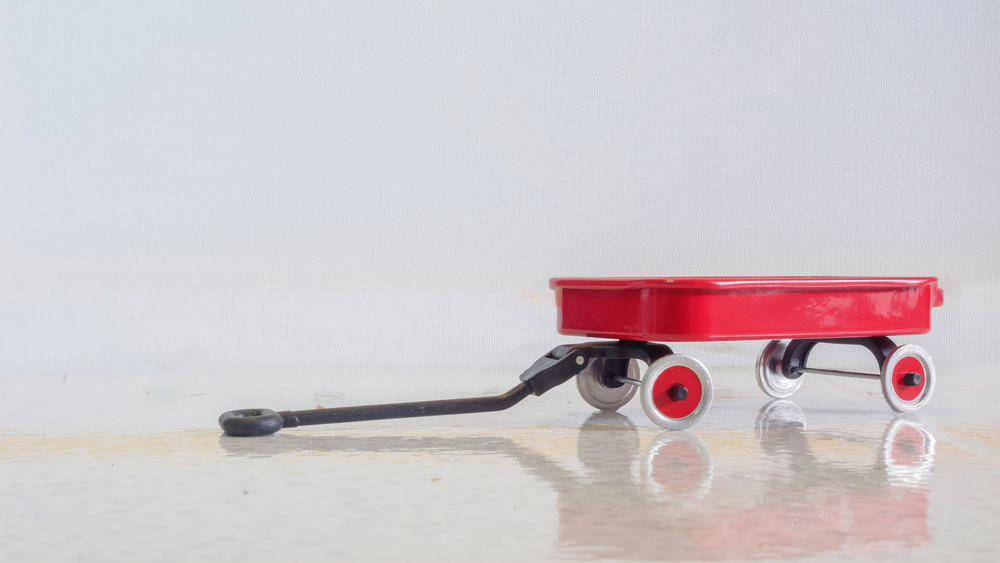
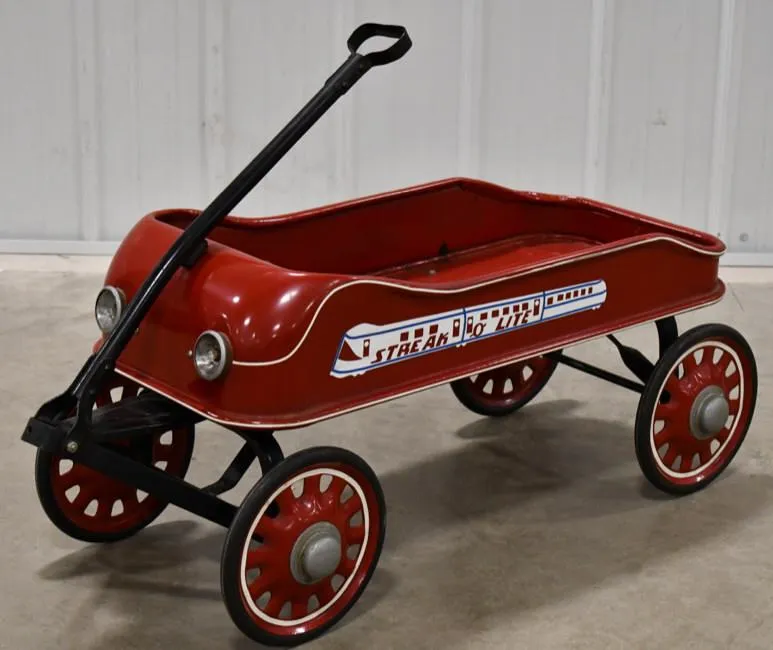
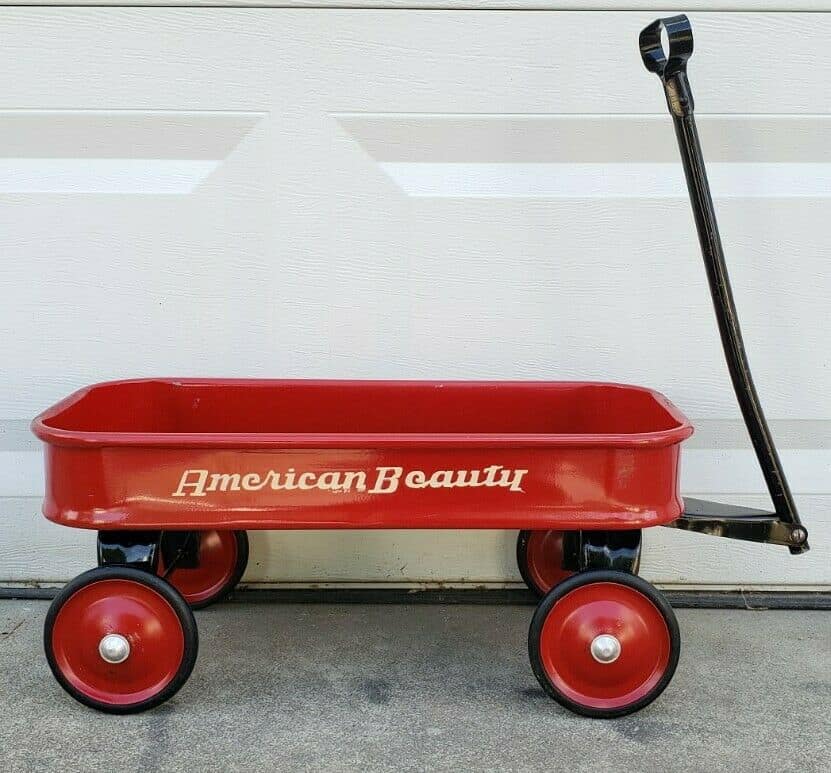
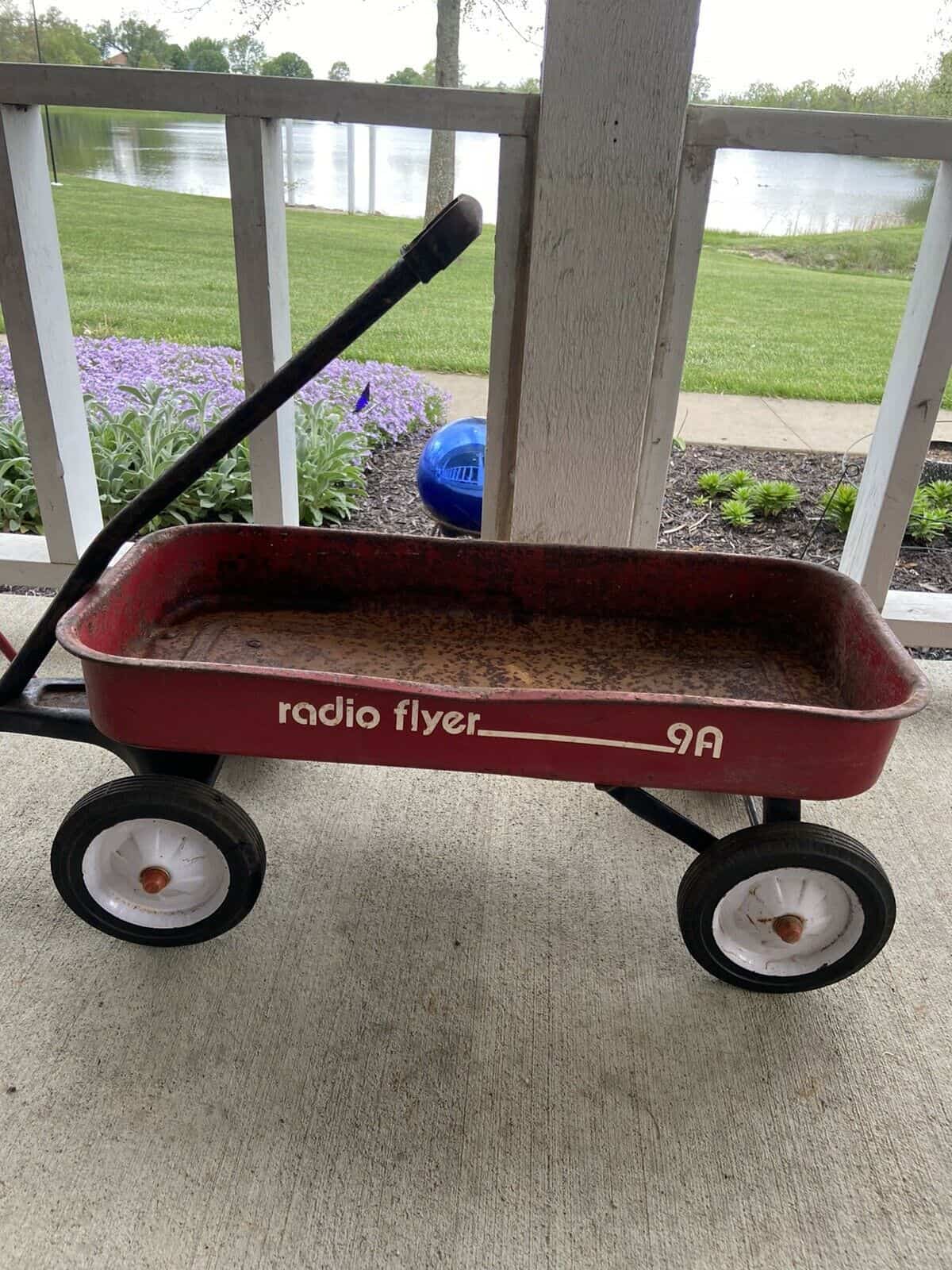
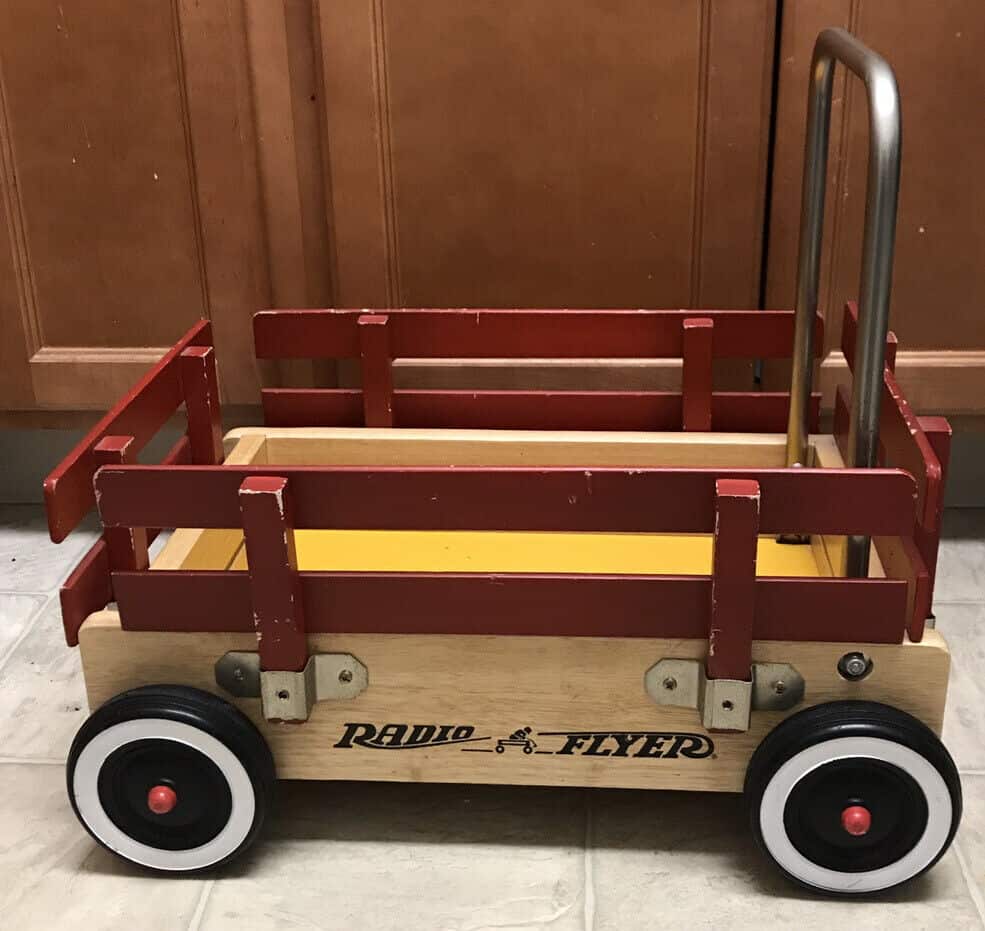
I have a Radio Flyer Town & Country wooden Wagon that doesn’t have the white wheels and has metal wheels. If you email me back and I send a picture, could you possibly be able to tell me how old you think it is? I have looked at all of them on ebay and none of them are like mine.
I can find the year of this Radio town & county online anywhere? It is a wooden 6 sided wagon. Can you help?
I have a radio flyer tricycle model 46/46g—where can I find more information regarding this model-age-price Parts etc
I have a radio flyer 90. I’m curious what the manufacturer date is but there isn’t a label on the underside. Can you help me find out?
Thanks!
I have one too same problem
I bought a used old wooden radio flyer wagon out of a barn sale in 1995 that somebody painted green. There was some rust on the wheels. I bought it for sentimental reasons because I got one for Christmas in 1947 when I was 5 years old. I researched how to restore it to the red color and bought Radio Flyer decals. I Managed to get rid of the rust and touch up the white paint on the wheels. I held onto it all these years and even made a mattress for it. I put a couple of old dolls I had in it. I thought I would eventually give it to my first great grand children only to learn his parents bought him a canvas Flyer wagon. So then again I thought I give it to the next child but she was given a small motorized motorcycle and I thought she wouldn’t be interested in the wagon. Her sister the same story. I didn’t make my wishes known as I wanted it to be a surprise. Well finally, I have a new great grandson and I’m giving the wagon to him this Christmas. He’s will only be 9 months but I figured I better act fast before they get him anything like a wagon or a motorcycle. I must say I enjoyed mine when I was 5 and again having the one I’m about to give as a gift. At 81 years old I think it’s about time to pass it on. Thanks for the memories